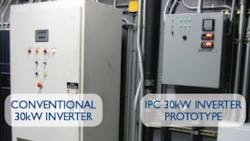High-tech solar inverter weighs in at under 100 lb
A start-up called Ideal Power Converters in Austin, Tex. says it recently flipped the on-switch for a test of its prototype 30 kW commercial-scale PV inverter. The device's claim to fame is its small form factor and elimination of magnetic components ordinarily required for switch-mode power supply topologies.
The device uses a patented current-modulation electronic power converter technology. IPC says its inverter design is an order of magnitude smaller and lighter than conventional best-in-class inverters that deliver the same power (30 kW), output voltage (3-phase 480 Vac), and support for standard grounded PV arrays.
The company says its 30-kW prototype inverter system now powers a PV array at the Austin Convention Center. IPC’s initial product will be a 30-kW PV inverter for the U.S. market that weighs less than 100 lbs. The lightweight design will reduce indirect shipping and installation costs by more than 80%, says IPC, and will simplify installation of rooftop PV installations with space and structural support constraints.
One reason older inverter designs are bulky is that they typically incorporate isolation transformers and bulky output filters to keep harmonics out of the power line. The IPC design is a pulsed-current source dc-to ac-converter that uses a high frequency ac link between the input and the output. Inputs never connect directly to the output and hence there is inherent isolation between the two which allows neutral grounding of both the ac and the dc stages. This means there is no need to use an isolating transformer.
The IPC design forms an ac link with a low-reactive-rating inductor/capacitor pair. Energy transfer operations are completely indirect. The dc input from the PV panels first charges the link inductor. This inductive energy is then discharged to the output phases. The output current pulses are controlled precisely using an energy distribution scheme that ensures less than 3% harmonics below twice the link frequency.
IPC says commercial power switch technology has progressed to a point that makes it possible to realize a link frequency of 5 kHz or higher. All turn-on’s are at zero voltage and turn off losses are low because of the capacitive buffer across them. The converter is essentially a PWM current source although all link flows are ac with no dc offset.
More info: http://www.idealpowerconverters.com/technology.html
IPC principals wrote an IEEE paper on the inverter topology: http://www.idealpowerconverters.com/pdf/IPC_ICSET_2008_Solar_Inverter.pdf
